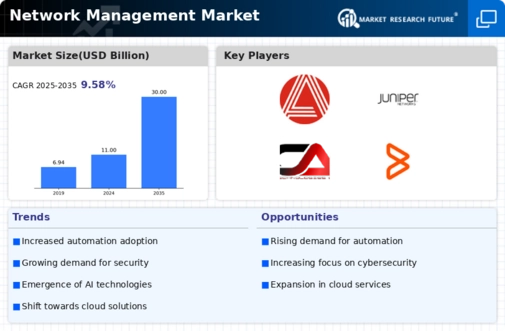Market Trends
Key Emerging Trends in the Network Management Market
The Network Management market is experiencing significant growth and is expected to witness further expansion in the coming years. As organizations increasingly rely on complex and interconnected networks, the need for efficient network management solutions becomes paramount. Network management encompasses various activities, including monitoring, troubleshooting, configuration, and performance optimization, to ensure the smooth functioning of networks.
One of the key market trends in the Network Management market is the adoption of Artificial Intelligence (AI) and Machine Learning (ML) technologies. These technologies enable organizations to automate network management tasks, analyze vast amounts of data, and detect anomalies or potential issues in real-time. AI and ML algorithms can identify patterns, predict network performance, and provide actionable insights to improve network efficiency. The integration of AI and ML into network management solutions is expected to drive the market growth as organizations seek to optimize their networks and proactively address network-related issues.
Another significant trend is the increasing demand for cloud-based network management solutions. With the rise of cloud computing and the proliferation of remote work, organizations require network management tools that can be accessed and managed from anywhere. Cloud-based solutions offer flexibility, scalability, and ease of deployment, making them an attractive choice for businesses of all sizes. Additionally, cloud-based network management solutions provide centralized visibility and control over distributed networks, enabling efficient monitoring and management.
The market is also witnessing a growing emphasis on network security management. As cyber threats continue to evolve, organizations are investing in robust security measures to protect their networks from unauthorized access, data breaches, and other malicious activities. Network security management solutions help organizations monitor network traffic, detect intrusions, and enforce security policies. With the increasing complexity of network infrastructures and the growing number of cyber threats, the demand for comprehensive network security management solutions is expected to rise.
Moreover, the market is experiencing a shift towards software-defined networking (SDN) and network virtualization. SDN separates the control plane from the data plane, allowing for centralized network management and control. Network virtualization, on the other hand, enables the creation of virtual networks that can be easily provisioned and managed. These technologies provide organizations with agility, scalability, and flexibility in managing their networks. The adoption of SDN and network virtualization is expected to drive the demand for network management solutions that can effectively manage these virtualized and software-defined environments.
Additionally, the market is witnessing the integration of network management solutions with Internet of Things (IoT) devices. As more IoT devices are deployed in various industries, the need for efficient network management solutions to handle the increased network traffic and device management becomes crucial. Network management solutions that can effectively monitor and manage IoT devices, ensure network connectivity, and address security concerns are in high demand.
In terms of geographical trends, North America currently dominates the Network Management market, owing to the presence of major technology players and a mature IT infrastructure. However, the Asia-Pacific region is expected to witness significant growth in the coming years, driven by the rapid digitization efforts, increasing adoption of cloud-based services, and growing IT investments in emerging economies.









Leave a Comment